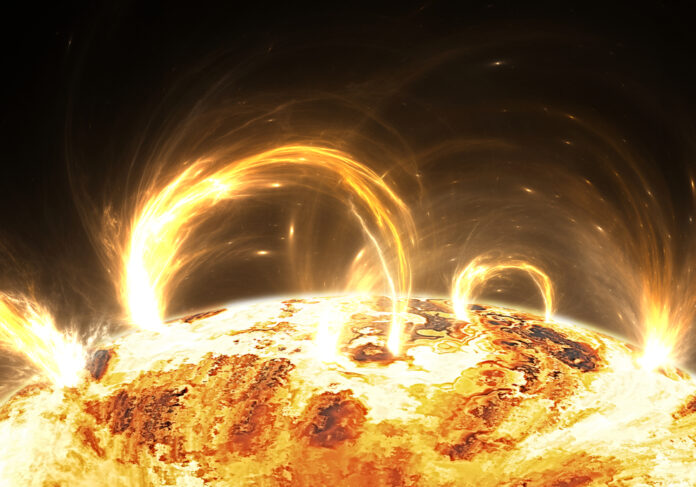You’re standing on the moon, gazing up at the Sun without the protective blanket of an atmosphere that we know and love on Earth. The sky is a stark, black canvas dotted with stars; the Sun is an unfiltered beacon. Now, picture this surreal scene interrupted by a massive solar flare, one of the most powerful explosions in our solar system.
What Are Solar Flares?
(Credit: Jurik Peter/Shutterstock)
Solar flares are intense bursts of radiation emanating from the Sun’s surface, caused by the sudden release of magnetic energy stored in the atmosphere. These events vary in intensity and are classified into different categories: A, B, C, M, and X, with X being the most severe. These flares are often accompanied by coronal mass ejections (CMEs), massive bubbles of solar plasma that erupt from the Sun’s outer layer and travel through space.
Imagine a billion-ton cloud of electrically charged, magnetized plasma hurtling toward Earth at several million miles per hour. This should be devastating for our planet, but fortunately, Earth is endowed with a magnetic field that deflects these particles. Thanks to our iron core, we get beautiful aurorae instead of lethal radiation.
Read More: Earth’s Magnetic Field Is Almost Similar to What it Was Like 3.7 Billion Years Ago
The Dangers of Solar Flares on the Moon
On the Moon, without an atmosphere or magnetosphere to scatter sunlight or block radiation, a solar flare would be a spectacular but potentially highly hazardous sight.
Expect an extremely bright flash. Solar flares release light across a wide spectrum, including visible light and ultraviolet (UV) radiation. This would make the Sun appear significantly brighter during the flare. Instruments that can detect UV light, like those used in solar observatories, would capture dramatic images of the flare.
These flashes are a result of the immense energy released during the flare and exist primarily in the form of X-rays and ultraviolet light. Observing this directly with the naked eye would be dangerous due to the high levels of radiation. The higher energy beams, like gamma rays, could even penetrate suits, affecting astronauts and equipment alike.
Read More: Solar Flares are Stunning but are They Dangerous? Here’s What to Know
Solar Storms Can Electrically Charge the Moon’s Soil
This is a map showing the permanently shadowed regions (blue) that cover about three percent of the Moon’s south pole. (Credit: NASA Goddard/LRO mission)
In the Moon’s polar regions, where some areas remain in permanent shadow, solar storms can cause the soil, or regolith, to become electrically charged. These “sparks” can potentially vaporize and melt the soil, similar to the effects of meteoroid impacts.
A 2016 study published in Icarus explored how solar storms can generate electric fields in the lunar regolith. The researchers found that the high-energy particles from solar flares could induce significant electrostatic charging, resulting in localized heating that could lead to vaporization.
Read More: What’s So Great About the Moon’s South Pole?
How Can We Predict Solar Flares?
NASA’s Solar Dynamics Observatory captured this image of a solar flare on Oct. 2, 2014. The solar flare is the bright flash of light at top. A burst of solar material erupting out into space can be seen just to the right of it. (Credit: NASA/SDO)
Bearing the brunt of a solar flare without protection is no joke. And as evidenced by a recent X1.9 class solar flare observed in July 2024, their presence is unavoidable.
For future space missions, understanding and preparing for solar flares is crucial. NASA’s Artemis missions, which aim to return humans to the Moon by 2025, include plans for shelters and protocols to protect astronauts from solar radiation.
Monitoring solar activity with satellites like the Solar and Heliospheric Observatory (SOHO) and the Solar Dynamics Observatory (SDO) helps provide early warnings of solar flares and CMEs, allowing for more timely action. Satellites can be put into a protective “safe mode,” and electrical grid operators can adjust power loads to account for blackouts.
Nonetheless, predicting solar flares and understanding their impact on space weather is still a field of active research. Analysis from the NOAA has shown that certain patterns on the Sun’s surface, such as the movement and interaction of sunspots, can help predict the likelihood of a solar flare occurring. This research is critical for planning long-term lunar and Martian missions.
Additionally, a 2023 study in the Journal of Space Weather and Space Climate discussed the potential for increased outbursts during the peak of the current solar activity cycle, further emphasizing the need for robust prediction models.
Read More: Satellite Collision Prediction Lost During Recent Solar Storm
Is the Future of Solar Flare Prediction AI-Based?
Luckily, help might be on the way. In a paper published in Scientific Reports in 2023, scientists developed a cutting-edge tool called SolarFlareNet. This AI-based network predicts solar flares with remarkable accuracy, offering forecasts up to 72 hours in advance. By analyzing magnetic field data from active regions, the tool helps us prepare for these disruptive events.
So, while observing a solar flare from the Moon would be an awe-inspiring experience, the hardware on your space suit, and even the cells in your body, will likely have a rough ride. While our home planet protects us from such catastrophes, we can’t take such creature comforts for granted in the vacuum of space.
Read More: Are We Ready for the Next Big Solar Storm?
Article Sources
Our writers at Discovermagazine.com use peer-reviewed studies and high-quality sources for our articles, and our editors review for scientific accuracy and editorial standards. Review the sources used below for this article:
Source : Discovermagazine






